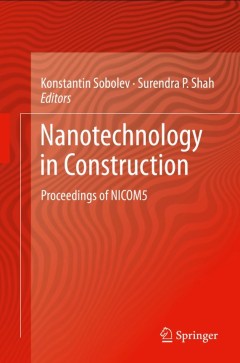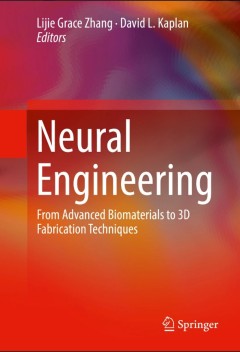Filter by

Nanotechnology in the Security Systems
The topics discussed at the NATO Advanced Research Workshop “Nanotechnology in the Security Systems" included nanophysics, nanotechnology, nanomaterials, sensors, biosensors security systems, explosive detection. There have been many significant advances in the past two years and some entirely new directions of research are just opening up. Recent advances in nano science have demonstrated th…
- Edition
- 1
- ISBN/ISSN
- 978-94-017-9004-8
- Collation
- XVII, 286
- Series Title
- NATO Science for Peace and Security Series C: Environmental Security
- Call Number
- -

Nanotechnology in Construction
Nanotechnology has already demonstrated surprising potential for improving the performance of construction materials and many of these recent developments were facilitated by NICOM symposia. The NICOM5 proceedings will cover the emerging opportunities and future use of nanotechnology in construction and will illustrate the broad potential for application of nanotechnology to challenging problem…
- Edition
- 1
- ISBN/ISSN
- 978-3-319-17087-9
- Collation
- XV, 509
- Series Title
- -
- Call Number
- -

Theoretical Modeling of Inorganic Nanostructures Symmetry and ab-initio Calc…
This book deals with the theoretical and computational simulation of monoperiodic nanostructures for different classes of inorganic substances. These simulations are related to their synthesis and experimental studies. A theoretical formalism is developed to describe 1D nanostructures with symmetric shapes and morphologies. Three types of models are considered for this aim: (i) nanotubes (rolle…
- Edition
- -
- ISBN/ISSN
- 978-3-662-44581-5
- Collation
- -
- Series Title
- -
- Call Number
- -

Nanotechnology for Chemical Engineers
The book describes the basic principles of transforming nano-technology into nano-engineering with a particular focus on chemical engineering fundamentals. This book provides vital information about differences between descriptive technology and quantitative engineering for students as well as working professionals in various fields of nanotechnology. Besides chemical engineering principles, th…
- Edition
- 1
- ISBN/ISSN
- 978-981-287-495-5
- Collation
- XI, 278
- Series Title
- -
- Call Number
- -

Encyclopedia of Polymeric Nanomaterials
Over the last few years, nanoscience and nanotechnology have been the focus of significant research attention, both from academia and industry. This sustained focus has in-turn driven the interdisciplinary field of material science research to the forefront of scientific inquiry through the creation and study of nanomaterials. Nanomaterials play an important role in the development of new mate…
- Edition
- -
- ISBN/ISSN
- 978-3-642-29648-2
- Collation
- 1234 b/w illustrations, 787 illustrations in colour
- Series Title
- -
- Call Number
- -

Neutron Applications in Materials for Energy
Neutron Applications in Materials for Energy collects results and conclusions of recent neutron-based investigations of materials that are important in the development of sustainable energy. Chapters are authored by leading scientists with hands-on experience in the field, providing overviews, recent highlights, and case-studies to illustrate the applicability of one or more neutron-based techn…
- Edition
- 1
- ISBN/ISSN
- 978-3-319-06655-4
- Collation
- X, 306
- Series Title
- Neutron Scattering Applications and Techniques
- Call Number
- -

Networked Learning
This book posits the idea that networked learning is the one new paradigm in learning theory that has resulted from the introduction of digital and networked technologies. It sets out, in a single volume, a critical review of the main ideas and then articulates the case for adopting a networked learning perspective in a variety of educational settings. This book fills a gap in the literature on…
- Edition
- 1
- ISBN/ISSN
- 978-3-319-01933-8
- Collation
- X, 249
- Series Title
- Research in Networked Learning
- Call Number
- -

Gute Technik für ein gutes Leben im Alter?: Akzeptanz, Chancen und Herausfor…
Längst gibt es altersgerechte digitale Assistenzsysteme. Doch sind Umfang und Geschwindigkeit ihrer Verbreitung sowohl in Pflegeeinrichtungen als auch in privaten Haushalten weitgehend unbekannt. Informationen zu tatsächlich eingesetzten Systemen, realisierten Umsätzen und Marktvolumen sind kaum zu finden. Obwohl es viele Vermutungen hinsichtlich der Hindernisse bei der Einführung altersger…
- Edition
- -
- ISBN/ISSN
- 9783839454695
- Collation
- -
- Series Title
- -
- Call Number
- 301 GUT g

Nanoporous Metals for Advanced Energy Technologies
This book covers the state-of-the-art research in nanoporous metals for potential applications in advanced energy fields, including proton exchange membrane fuel cells, Li batteries (Li ion, Li-S, and Li-O2), and supercapacitors. The related structural design and performance of nanoporous metals as well as possible mechanisms and challenges are fully addressed. The formation mechanisms of nanop…
- Edition
- 1
- ISBN/ISSN
- 978-3-319-80643-3
- Collation
- XIV, 223
- Series Title
- -
- Call Number
- -

Neural Engineering:From Advanced Biomaterials to 3D Fabrication Techniques
This book covers the principles of advanced 3D fabrication techniques, stem cells and biomaterials for neural engineering. Renowned contributors cover topics such as neural tissue regeneration, peripheral and central nervous system repair, brain-machine interfaces and in vitro nervous system modeling. Within these areas, focus remains on exciting and emerging technologies such as highly develop…
- Edition
- 1
- ISBN/ISSN
- 978-3-319-31431-0
- Collation
- VIII, 306
- Series Title
- -
- Call Number
- -
 Computer Science, Information & General Works
Computer Science, Information & General Works  Philosophy & Psychology
Philosophy & Psychology  Religion
Religion  Social Sciences
Social Sciences  Language
Language  Pure Science
Pure Science  Applied Sciences
Applied Sciences  Art & Recreation
Art & Recreation  Literature
Literature  History & Geography
History & Geography